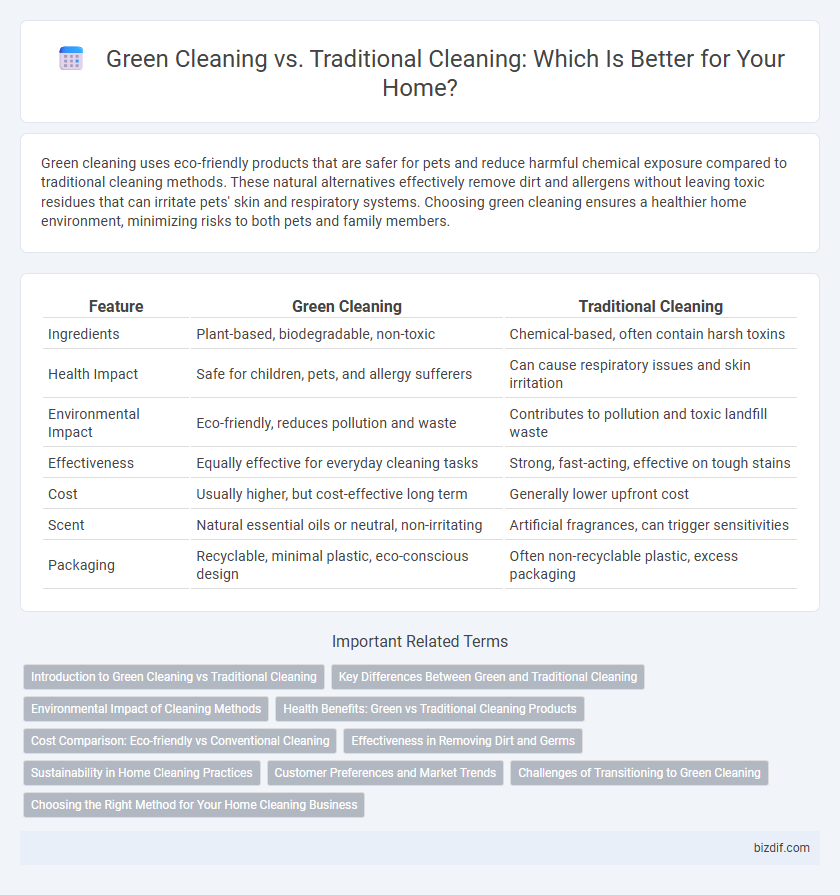Green cleaning uses eco-friendly products that are safer for pets and reduce harmful chemical exposure compared to traditional cleaning methods. These natural alternatives effectively remove dirt and allergens without leaving toxic residues that can irritate pets' skin and respiratory systems. Choosing green cleaning ensures a healthier home environment, minimizing risks to both pets and family members.
Table of Comparison
| Feature | Green Cleaning | Traditional Cleaning |
|---|---|---|
| Ingredients | Plant-based, biodegradable, non-toxic | Chemical-based, often contain harsh toxins |
| Health Impact | Safe for children, pets, and allergy sufferers | Can cause respiratory issues and skin irritation |
| Environmental Impact | Eco-friendly, reduces pollution and waste | Contributes to pollution and toxic landfill waste |
| Effectiveness | Equally effective for everyday cleaning tasks | Strong, fast-acting, effective on tough stains |
| Cost | Usually higher, but cost-effective long term | Generally lower upfront cost |
| Scent | Natural essential oils or neutral, non-irritating | Artificial fragrances, can trigger sensitivities |
| Packaging | Recyclable, minimal plastic, eco-conscious design | Often non-recyclable plastic, excess packaging |
Introduction to Green Cleaning vs Traditional Cleaning
Green cleaning utilizes eco-friendly products and methods to minimize environmental impact and reduce harmful chemicals in the home. Traditional cleaning relies on synthetic chemicals and disinfectants that can contribute to indoor air pollution and skin irritation. Choosing green cleaning promotes healthier living spaces and supports sustainability by reducing toxic residues.
Key Differences Between Green and Traditional Cleaning
Green cleaning uses eco-friendly, non-toxic products that reduce indoor air pollution and environmental impact, while traditional cleaning relies on chemical-based agents that may contain harmful substances. Green cleaning methods prioritize sustainability and health by avoiding harsh chemicals, whereas traditional cleaning often focuses on disinfecting and removing stains quickly with potent chemicals. The main difference lies in the choice of cleaning agents and their effects on human health and ecological systems.
Environmental Impact of Cleaning Methods
Green cleaning uses biodegradable, non-toxic ingredients that significantly reduce water pollution and air contamination compared to traditional cleaning products, which often contain harsh chemicals like ammonia and phosphates. These eco-friendly methods minimize environmental damage by lowering greenhouse gas emissions and reducing chemical runoff into ecosystems. Choosing green cleaning products supports sustainable practices by preserving biodiversity and promoting safer indoor air quality.
Health Benefits: Green vs Traditional Cleaning Products
Green cleaning products use natural ingredients that reduce exposure to harmful chemicals often found in traditional cleaning agents, leading to improved indoor air quality and reduced respiratory issues. Traditional cleaning products frequently contain volatile organic compounds (VOCs) and toxins like ammonia and chlorine, which can cause skin irritation, allergies, and long-term health risks. Choosing green cleaning methods minimizes the risk of chemical-related illnesses and supports a safer environment for children, pets, and those with sensitivities.
Cost Comparison: Eco-friendly vs Conventional Cleaning
Eco-friendly cleaning products typically have a higher upfront cost compared to conventional cleaning supplies, but they often result in savings by reducing health risks and environmental damage. Traditional cleaning methods may be less expensive initially, but the long-term costs related to chemical exposure, waste disposal, and potential damage to surfaces can lead to higher overall expenses. Green cleaning offers a cost-efficient alternative by promoting sustainability and minimizing harmful impacts while maintaining effective results.
Effectiveness in Removing Dirt and Germs
Green cleaning products utilize natural ingredients such as vinegar, baking soda, and essential oils that effectively eliminate dirt and germs while reducing chemical exposure. Traditional cleaning agents often contain strong synthetic chemicals like ammonia and bleach, providing powerful disinfection but posing potential health and environmental risks. Studies show that well-formulated green cleaners can match the effectiveness of conventional products in removing common household contaminants and pathogens.
Sustainability in Home Cleaning Practices
Green cleaning uses eco-friendly products and methods that minimize environmental impact by reducing harmful chemicals and waste, promoting sustainability in home maintenance. Traditional cleaning often relies on synthetic chemicals that can contribute to indoor air pollution and water contamination, posing risks to both health and ecosystems. Embracing green cleaning practices supports long-term environmental health and reduces the carbon footprint associated with household cleaning routines.
Customer Preferences and Market Trends
Consumers increasingly prefer green cleaning products due to their non-toxic ingredients and environmental benefits, driving a significant shift in home cleaning market trends. Market analysis reveals a rising demand for eco-friendly solutions, with over 60% of customers prioritizing sustainability and health safety in their purchasing decisions. Traditional cleaning methods face declining popularity as awareness grows about chemical exposure and environmental impact.
Challenges of Transitioning to Green Cleaning
Transitioning to green cleaning presents challenges such as the higher upfront costs of eco-friendly products compared to traditional chemical cleaners, which can impact budgeting for both households and businesses. Effectiveness concerns arise as some users find green alternatives less potent against tough stains and germs, requiring adaptation in cleaning techniques or longer cleaning times. Limited availability and lack of awareness about certified green cleaning products further complicate widespread adoption and consistent implementation.
Choosing the Right Method for Your Home Cleaning Business
Green cleaning utilizes eco-friendly, non-toxic products that reduce environmental impact and improve indoor air quality, appealing to health-conscious clients and sustainability-focused markets. Traditional cleaning often relies on chemical-based agents that provide powerful stain removal and disinfection but may pose health risks and environmental concerns. Selecting the right method depends on client preferences, cost considerations, and regulatory requirements, balancing effectiveness with safety and market demand.
Green cleaning vs Traditional cleaning Infographic

 bizdif.com
bizdif.com